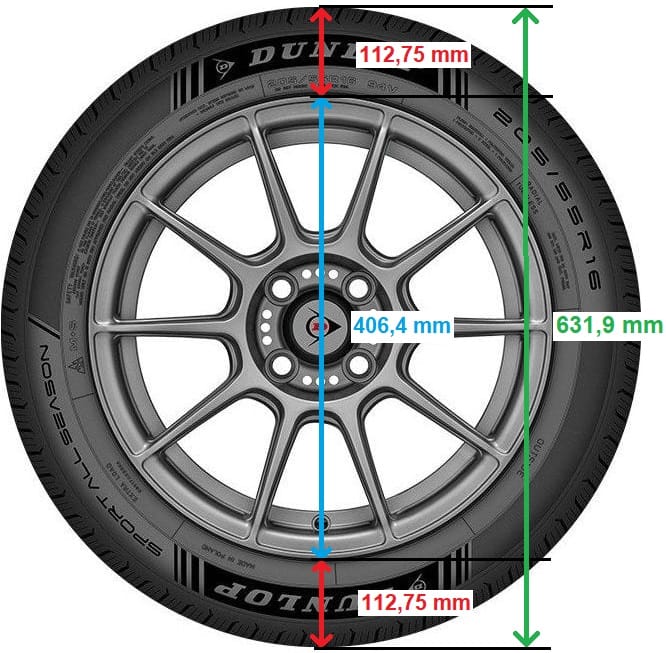Subjects:
- Calculator
- Tire height and static rolling circumference
- Calculation example
calculator:
Placing the wrong tire size under the car will result in a deviation on the odometer. The exact amount of the deviation can be calculated in the calculator below. Click on the image to open the calculator in a new screen. At the top of the table, enter the tire size that belongs under the car (which now reads 205/55R16) and below that the tire size that you want to know if it is suitable for mounting.
Tire height and static unwinding circumference:
The static tire height and rolling circumference can be calculated in the calculator. This is ideal when looking for a different tire size (e.g. changing from 16 to 18 inch) that can fit under the car without affecting the speedometer display.
The tire in the example is marked: 205/55 R16:
- 205 = tread width in mm
- 55 = tire height from road surface to underside of rim = 55% of 205 (0.55 x 205 = 112.75 mm)
- 16 = rim diameter in inches (1 inch = 25.4 mm, so 16 inch x 25.4 mm = 406.4 mm)
Enter these 3 values in the calculator to calculate the tire height and the static rolling circumference in an unloaded condition. The tire height is twice the height in millimetres, plus the rim diameter in millimetres. So in the example above: 112,75 + 112,75 + 406,4 = 631,9 mm (or 63,19 cm). In this calculator you can easily calculate the tire heights of different tire sizes and the difference in circumference and speed.

The two tire sizes that are standard in the table (the 205/55R16 and the 225/40R18) have a very small difference in height and circumference. As a result, the speed difference on the odometer is also minimal. This means that if the size 205/55R16 is specified by the manufacturer, wheels with tire size 225/40R18 can also be fitted. The only question then is whether the wider tires will not run into the wheel arches. If this is the case when you send it in, it can cause a lot of wear to the tire and that is a reason for rejection at the MOT. In that case, track wideners offer a solution.
More information about the band can be found on the page wheels and tires.
Calculation example:
When a tire size 205/55 R16 is mounted (from the factory) and someone wants to mount other (larger) rims + tires, a number of things must be taken into account. The ET value must be correct, the tires must not run into the shock absorber, wheel arch or wishbones and the static rolling circumference must not differ too much. The static roll-off circumference can be calculated with this calculator.
The tire size 205/55R16 has a static rolling circumference of 1,99 m. When a line is drawn with a chalk on the sidewall of the tire and the road surface and the wheel is turned one full revolution, then at the level of the line on the sidewall places a line on the road surface, the distance between these lines is 1,99 metres. This is important for the speedometer in the car. We now compare the tire size 225/40R18 and we see that the rolling circumference is now 2,00 m. This difference is minimal, making this tire size suitable for the car (provided it does not run into anything).
When the size 225/45R18 is calculated, a static roll-off circumference of 2,07 m can be seen. Compared to the 205/55R16, this is too much of a difference, which would indicate a lower speed on the speedometer (because the wheel takes longer to turn a complete circle). This tire size is therefore not recommended for mounting.
You can look up which tire sizes are prescribed for the car in the instruction manual or on Autoweek.nl, for example. Various tire sizes can be compared with this calculator.

